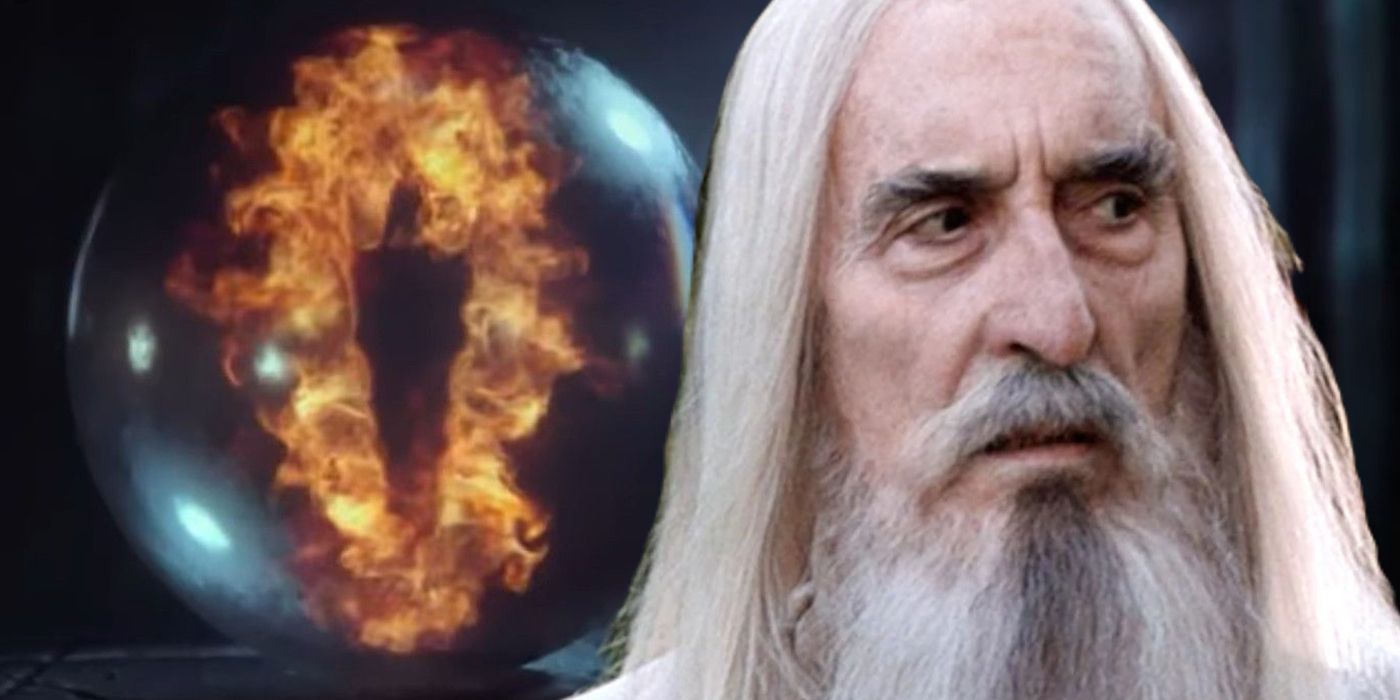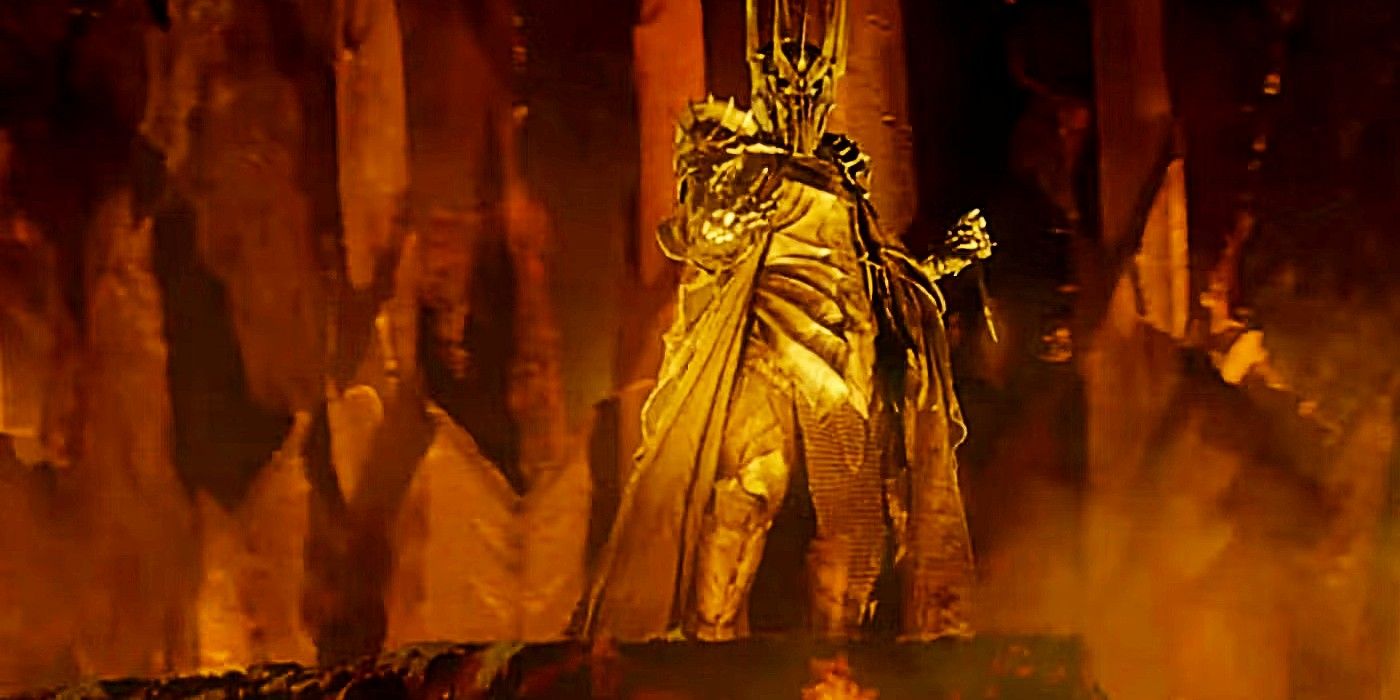The Dark Lord Sauron and the White Wizard Saruman were the two main villains of J. R. R. Tolkien’s The Lord of the Rings, and by the end of the story, both of them seemingly met their ends. Sauron’s power was tied to that of the One Ring, so he perished when it fell into the fires of Mount Doom. The timing and location of Saruman’s demise differed between the novel and Peter Jackson’s film adaptations, but in each, Grima Wormtongue betrayed him shortly before dying himself.
Yet the end of The Lord of the Rings was not truly the end for either Sauron or Saruman. They were both divine spirits called Maiar, just like Gandalf. Though their physical bodies were susceptible to damage, their souls were immortal, so they could never truly die. This was the reason that Sauron was able to return after his defeat by Isildur in the Second Age. Tolkien’s novels revealed what became of Sauron and Saruman after they died in The Lord of the Rings and why Sauron’s second defeat was very different from his first.
Updated on September 30, 2024, by Ajay Aravind: It is widely acknowledged by the Tolkien fandom that The Two Towers refers to Barad-dûr and Orthanc. As the headquarters of Sauron and Saruman, respectively, both these locations are critical in the War of the Ring. However, they pale in comparison before their creators, two of the strongest entities to ever walk Middle-earth. As such, we have updated this article with some more relevant information about Sauron and Saruman’s shared origins and to reflect CBR’s new formatting standards.
Where Did Sauron & Saruman Come From?
They Were Created Long Before the World Came into Existence

Both Sauron and Saruman, along with heroic characters like Gandalf and Radagast, were born in the Timeless Halls of Ilúvatar. These two future villains entered the world following its creation, where they pledged their allegiances to Aulë, the Smith of the Valar. Then known as Mairon, Sauron earned praise for his many virtues, including his desire for organization and order. Unfortunately, he grew so obsessed with the concept of perfection that his very goals changed. Sauron subsequently began to follow Morgoth, the first Dark Lord, marking his initial descent into darkness.
Name
Aliases
Base of Operations
Portrayed by
Sauron
Mairon, Gorthaur, Annatar
Mordor
Sala Baker, Charlie Vickers
Saruman
Curumo, Curunír, Sharkey
Isengard
Sir Christopher Lee
On the other hand, Saruman remained uncorrupted for much longer. In fact, Sauron had already been Morgoth’s servant for thousands of years by the time Saruman was chosen to go to Middle-earth. At this point, Saruman portrayed himself as noble and wise, explaining why he went on to be the Istari’s leader. Although he deeply resented his fellow Wizards from the very beginning, Saruman only truly exposed his vicious nature around the The Lord of the Rings timeline. He fell prey to envy and greed, going so far as to breed an entirely new type of Orc.
Sauron Was Powerless Without the One Ring
He Had Put Most of Himself into the One Ring
Sauron was the first of the two to die in the novel. He was in his tower of Barad-ûr for the duration of The Lord of the Rings, and it collapsed upon the One Ring’s destruction, taking him with it. The soldiers at the Battle of the Black Gate witnessed Sauron’s spirit rise from his body. In the chapter “The Field of Cormallen” from The Return of the King, Tolkien wrote, “as the Captains gazed south to the Land of Mordor, it seemed to them that, black against the pall of cloud, there rose a huge shape of shadow, impenetrable, lightning-crowned, filling all the sky.” Terrifying as this was, Sauron posed no physical threat anymore — he was “terrible but impotent,” and the shadow soon dissipated in the wind.
In “The Last Debate,” an earlier chapter of The Return of the King, Gandalf described what would happen to Sauron if Frodo’s mission was successful:
His fall will be so low that none can foresee his arising ever again. For he will lose the best part of the strength that was native to him in his beginning, and all that was made or begun with that power will crumble, and he will be maimed for ever, becoming a mere spirit of malice that gnaws itself in the shadows, but cannot again grow or take shape.
In other words, Sauron technically survived, but he was utterly powerless. He couldn’t even make a new body after the One Ring was destroyed. However, Gandalf pointed out that Sauron’s defeat would not automatically bring peace. Many of Sauron’s minions survived his downfall, and there were other evils in Middle-earth that Sauron did not control. That said, Aragorn’s reign for the first 123 years of the Fourth Age was generally less violent and chaotic.
Sauron and Saruman Met the Same Fate
Their Spirits Were Scattered to the Winds

A single line from The Silmarillion sheds light on what Sauron did after The Lord of the Rings. In the section “Valaquenta,” Tolkien wrote that Sauron “walked behind [Morgoth] on the same ruinous path down into the Void.” If literal, this meant that Sauron’s spirit went to join his former master in the Void, the mysterious space outside of creation to which the Valar had banished Morgoth in the First Age. There was a prophecy that Morgoth would one day return to Middle-earth, so if Sauron had indeed joined him, there was a chance for him to return as well. But even if he did, it would accomplish little, as Morgoth was destined to lose once again.
The White Wizard’s fate was very similar to the Dark Lord’s. In the novel, after Wormtongue killed Saruman, the hobbits saw his spirit rise from his body, much like Sauron’s. However, Saruman’s spirit was smaller, and it resembled a gray cloud instead of a black shadow. This indicated that he was weaker — and perhaps less evil — than Sauron. Hoping for forgiveness, Saruman’s spirit attempted to go west towards Valinor, but a frigid wind from the west blew him away. The Lord of the Rings did not elaborate any further on Saruman’s future, but Unfinished Tales of Númenor and Middle-earth did. The section titled “The Istari” explains it quite clearly:
Whereas Curunír was cast down, and utterly humbled, and perished at last by the hand of an oppressed slave; and his spirit went whithersoever it was doomed to go, and to Middle-earth, whether naked or embodied, came never back.
Saruman’s Punishment Might Not Have Lasted Forever
The Valar are Known for Offering Second & Third Chances

In some ways, Sauron and Saruman met a fate worse than death. They could do nothing but watch as their enemies destroyed all that they had built and undid the damage that they wrought in Middle-earth. The ever-scheming Maiar might have attempted to reclaim power, but it would have been in vain. Even Tolkien’s unfinished sequel to The Lord of the Rings, in which people forgot the horrors of the War of the Ring and began turning to evil practices, did not indicate that Sauron or Saruman could return. Their fates were sealed — or so it seemed.
The Valar gave multiple chances to even the vilest of individuals. They imprisoned Morgoth for thousands of years after his initial defeat, but once he had served his time, they set him free, inadvertently allowing him to begin another reign of terror in Middle-earth. The Valar likewise gave Sauron a chance to repent after the War of Wrath, although he did not take it and ran away instead. Saruman’s betrayal was his first crime against the Valar, so they might have eventually allowed him to redeem himself. Tolkien specifically wrote that Saruman never returned to Middle-earth, but Valinor was not part of Middle-earth. Of course, given the precedent that Morgoth and Sauron set, Saruman might have just squandered his second chance as well.

